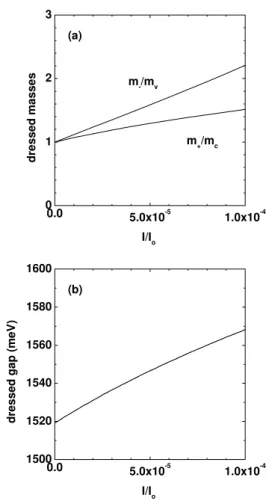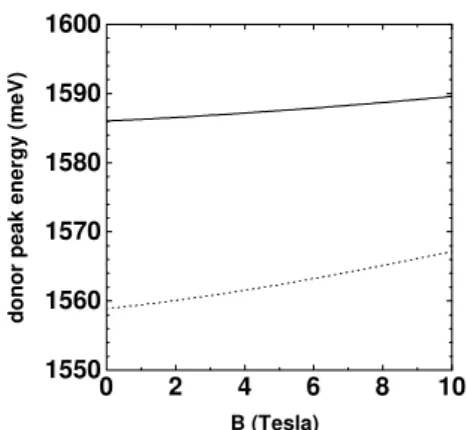Laser Eets in Semiondutor Heterostrutures Within
an Extended Dressed-Atom Approah
H.S.Brandi a
, A. Latge b
, and L.E. Oliveira
a
InstitutodeF
isia,Univ. FederaldoRiodeJaneiro,RiodeJaneiro-RJ,21945-970,Brazil
b
InstitutodeF
isia,Univ. FederalFluminense,Niteroi-RJ,24210-340,Brazil
InstitutodeF
isia,Uniamp,CP6165,Campinas-S~aoPaulo,13083-970,Brazil
ReeivedonApril22,2001
Weextendthedressed-atomapproahtotreattheinterationofalasereldwithasemiondutor
system. ThesemiondutorismodeledviaasimpleKaneband-strutureshemeandtheinteration
with the lasereldis inorporated throughthe renormalization ofthe semiondutorenergygap
andondution/valeneeetivemasses. Farfromresonanes,suhone-bodyapproahallows the
studyoftheeetsoflasereldsonavarietyofoptoeletroniphenomenainsemiondutorsystems
for whihtheeetive-massapproximationprovidesagoodphysialdesription. Wealulatethe
eets originated by the laser-dressing onthe donorand exiton peak energiesin quantum-well
heterostrutures,andshowthattheymaybequiteonsiderableandobservable.
I Introdution
Thepossibilitiesto designnew eÆientoptoeletroni
swithes and modulators may be greatly improved if
weareabletounderstandthebasiphysisinvolvedin
theexternaleld-semiondutorinteration. A
onsid-erableamountofworkhasbeendevotedtothestudyof
theinteration of externaleletriandmagneti elds
[1℄ with semiondutor quantum wells and
superlat-ties, and the physial proesses are now well
under-stood. Amoreompliatedsituationourswhenlight
interatswithasemiondutor,andadetailed
desrip-tion of the laser-semiondutor interation requires a
many-body treatment, as exitations (real or virtual)
suhasexitonsarereatedandinterat viaCoulomb
fores[2,3℄.
In the present work we study the eets of a
laserbeamin theexitonstatesinsemiondutor
het-erostrutures. We also disuss how an homogeneous
and monohromati laser beam modies the
impu-rity states of GaAs-(Ga,Al)As semiondutor
quan-tum wells (QWs) under applied magneti elds
per-pendiular to the QW interfaes. A realisti
desrip-tion of the laser eets on shallow-impurity states in
semiondutor heterostrutures under magneti elds
would, in priniple, require omplex alulations
in-volving, for instane, Coulomb interations between
impurities and all virtual exitoni states.
Neverthe-less,amuh simplersituationours whenthelaseris
tuned farfrom any resonanes,sinethe main physis
iallydesribedbyusing anon-perturbativeone-body
approximation [4, 5, 6℄. From the experimental point
of view, the shifts on the impurity levels indued by
thelaserlightmaybeusedasapossibleappliationto
ultrafast opto-eletroni devies where no photon
ab-sorptionours inthedevie.
Here we onsider a desription of the
semiondu-tor system whih inludes spin-orbit oupling within
the Kane model [7℄. The alulations are based on a
steady-statemodelwhereasatualexperimentsdealing
withhangesintheeletronistrutureofthe
semion-dutorsystemareperformedusingultrafastlaserpulses
andintensitiesofGW/m 2
(the pulsed-laserregime in
whih the agreement with steady-state results is
ex-petedhasbeenextensivelyinvestigatedboth
theoret-iallyandexperimentally[3℄).
II Laser-dressed 3-band Kane
model
WeadopttheKanemodeltodesribethesetofstates
formed by thelowest ondution band (
6
), the
high-est light- and heavy-hole valene bands ( lh;hh
8
), and
thesplittedspin-orbitband(
7
),whihissplittedfrom
theothertwodegeneratedvalenebandsby.Inwhat
follows,weuseasabasisthe statesobtainedfrom the
diagonalizationoftheKanematrix[8℄. Theeet ofa
H =H o +~!a + a+ e m o A ! ^ p: ^(a
+
+a); (1)
where H
o
is the diagonal matrix obtained from the
Kane model, and a +
(a) is the reation (annihilation)
photonoperator assoiatedwiththelasermodeof
fre-queny! and polarization^. Thevauumeld
ampli-tudein thevolumeisgivenbyA
! =( 2~ 2 ! ) 1 2 whih
is relatedtothelassialamplitudeofthephoton
ve-tor potential A
o by A o = 2(N o ) 1=2 A ! for N o >> 1, where N o
>> 1 is the average number of photons in
the eld. Using the states obtained from the
diago-nalization of theKane matrix,it isstraightforwardto
extend the dressed-atomapproah [9℄ and diagonalize
the Hamiltonian of eq. (1) within the j
8
;N+1>
j
8
>jN+1>and j
6
;N >j
6
>jN >
mani-fold,wherejN >representsaFokstatewithN N
o
photons[9,10℄.
From the diagonalization of the Hamiltonian, one
obtains[6℄theassoiatedlaser-dressedondution(+)
andvalene(-)eletronibands, i.e.,
= o ~! 2 + 2 o 6Æ 0 1 2 s 8 2 o 3 + Æ+ 2 0 3Æ 0 + 4 2 0 3 1 2 + ~ 2 k 2 2m ; (2)
and orresponding renormalized eetive masses m
(see Brandi et al [6℄). In the above expression,
o is
thesemiondutorenergygap[8℄,Æisthelaserdetuning
givenby
o ~!,Æ
0
=Æ+ ,and
1 =
o
+ ~!. The
har-ateristi energyassoiatedto thelaser-semiondutor
interation isrelatedto
o =( eA o jpj 2m o ).
Note that the k-dependent semiondutor energy
gap is dressedbylaser eets, andis givenbythe
dif-ferenebetweentheaboverenormalizedondutionand
valeneeletroni bands
~ o (k)= o Æ+ s 8 2 o 3 + Æ+ 2 0 3Æ 0 + 4 2 0 3 1 2 + ~ 2 k 2 2 ; (3) with 1 = 1 m + 1 m .
Theaboveequationsprovidetheframeworkfor
al-ulating laser eets onsemiondutorsystemswithin
theKaneband-struturepiture.
The dependene of the laser-dressed
ondution-and valene-bandeetivemassesandthe
orrespond-ing behaviorof the dressed k = 0 semiondutor
en-ergygap[f. eq.(3)℄areshowninFigure1(where[4,5℄
I
o
510 7
MW=m 2
) for alaser detuning Æ = 0.05
o
, and parametersorresponding to bulkGaAs. Itis
lear that lasereets orrespondto a
renormaliza-0.0
5.0x10
-5
1.0x10
-4
0
1
2
3
m
-
/m
v
m
+
/m
c
(a)
d
ressed
m
asses
I/I
o
0.0
5.0x10
-5
1.0x10
-4
1500
1520
1540
1560
1580
1600
(b)
d
ressed
g
a
p
(
m
eV
)
I/I
o
Figure1. GaAs laser-dressedeetivemasses for the
on-dution (m+) and valene (m ) bands, and energy gap.
Resultsdisplaythedependeneonthe laserintensityfor a
xeddetuningÆ=0=0.05.
theondution/valene eetivemasses. Also, a
om-parisonofthe presentresultswith theprevious
alu-lationbasedonatwo-bandmodelsemiondutor[4,5℄
indiates that results are qualitatively the same, the
dierenes inreasing for smaller detunings and high
laser intensities, as one would expet. Therefore, we
mayinferthat laserdressingdoesnotstronglydepend
onthe modelling of the band struture, and therefore
thepresentKane-modelrenormalizedeetive-mass
ap-proah, valid within the one-partile piture and for
a laser tuned far from any resonanes, may be used
to provide an adequate indiation of the laser eets
on any semiondutor heterostruture for whih the
eetive-massapproximationisagoodphysial
desrip-tion.
III Laser-indued exiton and
donor shifts in
GaAs-(Ga,Al)As quantum wells
in a100
AGaAs Ga
0:7 Al
0:3
As QW.The1s-like
ex-iton ground state was evaluated within a
frational-dimensional sheme[11℄ usingthe3-band Kane
renor-malized GaAs ondution/valene eetive mass and
dressed band gap. Results for the laser-intensity
de-pendene of the exiton shift (and peak energy) are
presented in Fig. 2 (and Fig. 3) for a laser tuned
far from exiton resonanes, i.e., Æ = 0.05
o . The
blue laser-induedshiftin theexitonpeakenergiesis
quite remarkable, and alulated results qualitatively
agree with femtoseond measurements by Mysyrowiz
etal[12℄. TheKane-modelontributionstotheexiton
Starkshift aredueto thelaser-induedhangesinthe
GaAs gap, exiton binding energy, and QW
onne-ment both of free eletrons and holes. It is apparent
from Fig. 2 thatthe main ontributionto theexiton
blueshiftisessentiallydue tolaser-induedhangesin
theGaAssemiondutorgap.Notiethat,inthelarge
detuning limit,perturbation theory (PT)in the
laser-dressed3-bandKanegapresultsinanexitonblueshift
given by 4
2
o
3Æ
, in ontrast with the 2-band model
ap-proah [4, 5℄ whih gives a larger detuning PT result
of 2
2
o
Æ
. This2-band PT resultfor theontribution of
thedressedgap totheexitonshiftorrespondstothe
sameexitonblueshift,inthelargedetuninglimit,
ob-tainedthrough amany-bodydiagrammati derivation
andinterpretedbyCombesot[2℄asomingfromPauli
exlusion betweenthe twoe-hpairs forming the
biexi-ton. We mention therefore that the present Kane
re-sultsdemonstratethatdressed-bandeetswithina
3-band modelalulationwould hangethezeroth-order
termofthe2-bandmany-bodydiagrammatiapproah
[2℄,andsuggestthattheontributionduetomore
real-istiband-dressingalulationsmaybeasimportantas
many-bodyorretions. Also,thepresentrenormalized
approahforevaluatingtheexitonbindingenergy
or-responds essentially to a diagrammati summation of
ladderdiagramsassoiatedwithlaser-dressede-h
bub-blesbuiltfromarenormalizedeletronanda
renormal-izedholein thepreseneoftheCoulomb interation.
As a seond appliation, we study the laser
ef-fetsontheon-enterdonor-impuritystatesofa100
A
GaAs Ga
0:7 Al
0:3
AsQWunderthepreseneofan
ap-pliedmagnetieldperpendiulartotheQWinterfaes
[1℄. Wefollowastandard variationalshemewithin a
renormalizedlaser-dressedeetive-massapproahand
hoosea1s-likeon-enter trialenvelopewavefuntion
asaprodutoftheexatsolutionofthesquarewellQW
potentialandahydrogeni-likevariational1sfuntion
[1℄. Weonsidertheeetsofalaseronthe1s-like
shal-lowdonorstateunder thepresene ofanapplied
mag-netieldperpendiulartotheQWinterfaes. Results
forthemagneti-elddependeneofthedonorpeak
en-ergy(transitionsfromthe1s-likedonorto therst
va-lenemini-band)aredisplayedinFig. 4forI=I
o =10
4
and a detuning parameter Æ = 0.05 . One noties
that the laser-dressed shift in the donor peak energy
is ofthesameorderof magnitudeoftheQWonned
donorbindingenergy,andmuhstrongerthanthe
or-respondingshiftinduedbytheappliedmagnetield.
Thestrongblueshiftonthedonorpeakenergyouldbe
easilyobservable,although,toourknowledge,thereare
noexperimentalmeasurementsonerninglasereets
onimpuritystatesindopedGaAs-GaAlAsQWs.
0
1
2
3
4
5
0
20
40
60
Kane
Kane gap
Kane PT
excit
o
n
sh
if
t (
m
eV)
Laser intensity (GW/cm
2
)
Figure2. Laser-intensitydependeneoftheexitonoptial
Stark shift for a 100
A GaAs Ga0:7Al0:3As QW and a
laser detuning Æ=0 =0.05. Thefull urvesrepresent the
Kane-modelontributionstotheexitonStarkshiftdueto
thelaser-induedhangesintheGaAsgap (labelled\Kane
gap"), andthetotal optialexiton Starkshift shownasa
fullurve(labelled\Kane"). Itisalsoshownthe
perturba-tive(KanePT)results(dashedurve).
0
1
2
3
4
5
1560
1570
1580
1590
excit
o
n
p
eak en
erg
y (
m
eV
)
Laser intensity (GW/cm
2
)
Figure 3. Laser-dressed exiton-peak energy for a 100
A
GaAs Ga
0:7 Al
0:3
AsQWasafuntionofthelaser
inten-sityandforadetuningparameterÆ=0.05
o .
IV Conlusions
Wehavepresentedatheoretialapproahofthe
laser-eld eetsonsemiondutorlow-dimensionalsystems
by adopting a piture in whih the light-matter
in-teration is taken into aount by dressing the
semi-ondutorenergygapandondution/valeneeetive
masses. Boththetwo-bandandthree-bandKane
shown to give essentially the same qualitative results
for thelaser dependene ofthedressed semiondutor
gap and orresponding eetive masses, although an
appropriate quantitative omparison with experiment
would ertainly requirea morerealisti desriptionof
thesemiondutorbandstruture.
0
2
4
6
8
10
1550
1560
1570
1580
1590
1600
donor
peak ener
gy (
m
eV
)
B (Tesla)
Figure 4. Laser-dressed on-enter donor-peak energiesfor
a 100
A GaAs Ga0:7Al0:3As QW for I=Io = 10 4
and
Æ =0.05 o. Dotted linesarethe orrespondingundressed
results.
Aknowledgments
The authors would like to thank the Brazilian
AgeniesCNPq,FUJB-UFRJ,FAPERJ,FAPESP,and
FAEP-UNICAMP forpartialnanialsupport.
Referenes
[1℄ A. Latge, N. Porras-Montenegro, M. de Dios-Leyva,
J.Ribeiro,A.Latge,andL.E.Oliveira,J.Appl.Phys.
80,2536(1996).
[2℄ M.Combesot,Phys.Reports221,167(1992).
[3℄ M. Lindberg andS.W. Koh,Phys.RevB 38,7609
(1988);C.Ell,J.F.Miller,K.ElSayed,andH.Haug,
Phys.Rev.Lett.62, 304(1989); S.M. Sadeghi,J.F.
Young,andJ.Meyer,Phys.Rev.B56,R15557(1997).
[4℄ H.S.Brandi,A.Latge,andL.E.Oliveira,Sol.State.
Commun. 107, 31 (1998); ibid., Phys. Stat. Sol. (b)
210,671(1998).
[5℄ H.S.BrandiandG.Jalbert,Sol.StateCommun.113,
207(2000);H.S.Brandi,A.Latge,andL.E.Oliveira,
PhysiaB:Phys.ofCond.Matter(inpress).
[6℄ H.S.Brandi,A.Latge, andL. E.Oliveira, Sol.State
Commun.117,83(2001);ibid.,Phys.Rev.B(inpress,
July15,2001).
[7℄ E.O.Kanein"Narrow GapSemiondutors. Physis
and Appliations", ed. by W. Zawadzki, Le. Notes
Phys.133(SpringerVerlag,Berlin,1980).
[8℄ G.Bastard, "Wave mehanis applied to
semiondu-tor heterostrutures". Les Editions de Physique, Les
Ulis,1988.
[9℄ C. Cohen-Tannoudji, J. Dupont-Ro, and G.
Gryn-berg, "Proessus d'interation entre photons et
atomes",EditionsduCNRS,1988.
[10℄ G.Jalbert,B.Koiller,H.S.Brandi,andN.Zagury,J.
Phys.C19,5745 (1986).
[11℄ A. Matos-Abiague, L. E. Oliveira, and M. de
Dios-Leyva,Phys.Rev.B58,4072(1998);E.Reyes-Gomez,
A.Matos-Abiague,C.A.Perdomo-Leiva,M. de
Dios-Leyva,andL. E.Oliveira,ibid.61,13104(2000).
[12℄ A.Mysyrowiz,D.Hulin,A.Antonetti,A.Migus, W.
T. Masselink, and H. Morko, Phys. Rev. Lett. 56,


